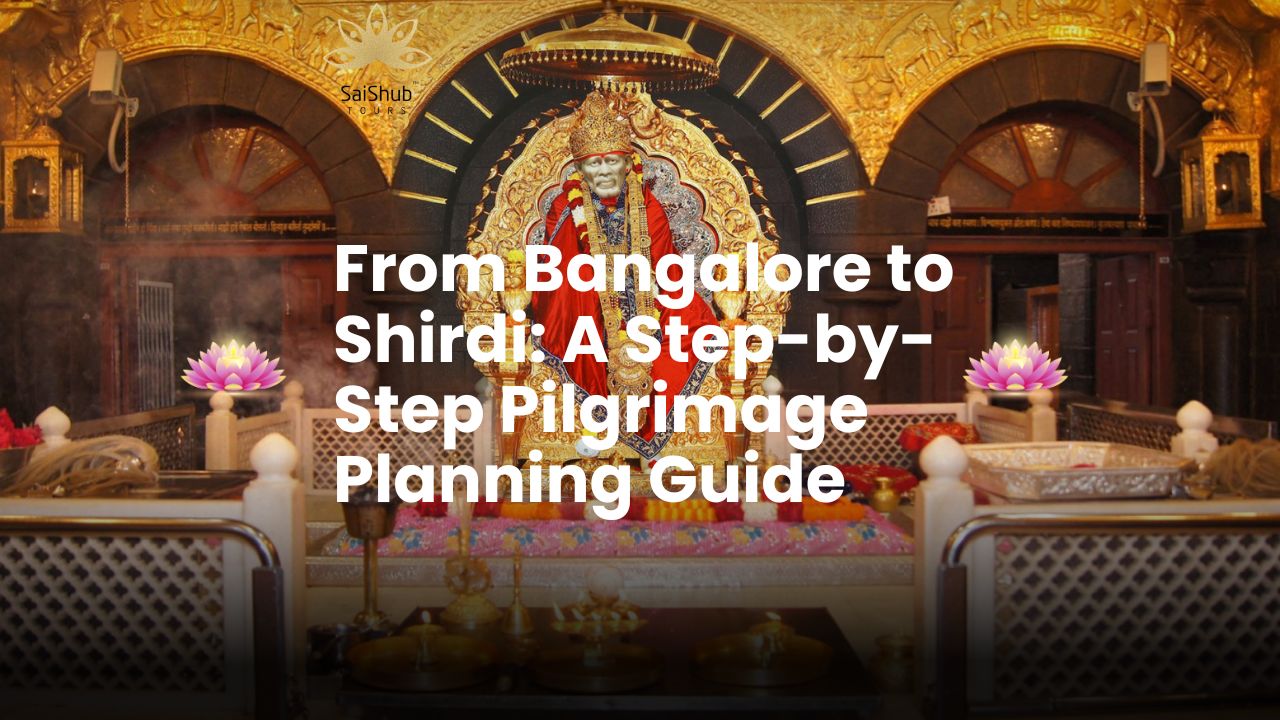
Planning a pilgrimage from Bangalore to Shirdi ? Whether you’re a first-timer or a seasoned traveler, visiting the sacred Shirdi Sai Baba Temple is always a spiritually enriching experience. But to truly enjoy the journey and avoid hassles, a well-organized plan is key.
In this guide, we’ll walk you through everything you need to know—from the best time to visit, transport options, what to pack, how to book darshan, and even what to do while you’re there. Let this be your go-to checklist for a peaceful and fulfilling Shirdi pilgrimage.
1. Why Shirdi? The Spiritual Significance
Shirdi is one of India’s most revered pilgrimage centers, known as the home of Sri Sai Baba, a 19th-century saint whose teachings on faith (Shraddha) and patience (Saburi) continue to inspire millions.
People travel to Shirdi for various reasons:
To seek blessings and guidance
To fulfill vows
To find peace and spiritual connection
To participate in rituals and festivals
Sai Baba’s message transcends religion, making this pilgrimage a unifying spiritual journey for people of all faiths.
2. Best Time to Visit Shirdi from Bangalore
Shirdi is accessible year-round, but the most pleasant months to travel are:
October to March: Comfortable weather, ideal for darshan and local sightseeing.
Ram Navami, Guru Purnima & Vijayadashami: Major festivals celebrated with grandeur at the temple.
Avoid peak summer (April to June) due to high temperatures.
3. How to Reach Shirdi from Bangalore
By Flight
Fastest & Easiest Option
Flights from Bangalore to Shirdi Airport or Aurangabad Airport (approx. 2 hrs)
Shirdi Airport is just 15 km from the temple.
By Train
Direct trains like Sainagar Express (via Kacheguda) connect Bangalore to Sainagar Shirdi.
Journey takes around 18–22 hours.
By Road (Car/Bus)
Distance: ~980 km
Duration: 16–18 hours by car or bus.
Sleeper and AC buses run frequently from Bangalore to Shirdi.
Travel Tip
For elderly pilgrims or group travel, consider a Shirdi tour package from Sai Shub Tours that includes transport, darshan booking, and accommodation.
4. Booking Temple Darshan
Shirdi Sai Baba Temple is usually crowded, especially on weekends and holidays. Book your darshan in advance:
Visit the official temple website: https://online.sai.org.in
Choose a preferred time slot (free or paid darshan)
Carry a valid photo ID
Pro Tip: Some tour operators like Sai Shub Tours offer VIP Darshan as part of the package.
5. Accommodation in Shirdi
Shirdi offers a range of options—from budget lodges to premium hotels:
Budget: Sai Ashram, Bhakta Niwas
Mid-range: Daiwik Hotels, Hotel Sai Grand Castle
Premium: Sun-n-Sand, St Laurn
Make sure to book in advance, especially during festive seasons.
6. What to Pack for a Shirdi Trip
Here’s a quick checklist to ensure a smooth journey:
Lightweight cotton clothes
ID proof for darshan
Footwear that’s easy to remove
Water bottle, umbrella (in summer), shawl (in winter)
Basic medicines and toiletries
Offerings like flowers, coconut, or prasad (optional)
7. Must-Do Experiences in Shirdi
Apart from the main Sai Baba temple, don’t miss:
Dwarkamai: The mosque where Sai Baba lived
Chavadi: Where he rested on alternate nights
Sai Heritage Village: A visual representation of Sai Baba’s life
Lendi Baug: A peaceful garden often visited by the saint
Prasadalaya: Serves free meals to thousands daily
8. How Sai Shub Tours Can Help You
Planning a pilgrimage shouldn’t be stressful. Sai Shub Tours, based in Bangalore, offers customized and affordable Shirdi tour packages that include:
Train or flight booking
Comfortable accommodation
Guided darshan
Sightseeing options
Special care for senior citizens
With professional service and over a decade of experience, you’re in good hands.
9. Tips for a Comfortable Pilgrimage
Arrive early for darshan to avoid long queues
Avoid buying expensive offerings from touts
Keep valuables safe; the temple can get crowded
Respect temple customs (dress modestly, maintain silence)
Drink bottled water to stay hydrated
FAQ
Ringing a temple bell helps prepare the mind for worship by removing distractions and focusing attention on the divine. It’s a way of announcing your arrival to the deity and creating a sacred atmosphere.
Yes, the sound produced by temple bells aligns with healing frequencies that calm the mind, balance the body’s energy, and aid in meditation. It’s considered a form of sound therapy in spiritual traditions.
The body of the bell symbolizes the universe, the clapper (tongue) represents speech or devotion, and the handle often features deities or symbols, showing divine protection.
Yes. In South India, large bells are often placed at temple entrances, while North Indian priests may use small handheld bells during aarti. The purpose remains spiritual across all regions.
According to Vastu and Hindu beliefs, the vibration of a ringing bell clears negative energy, purifies the space, and invites positivity, making the temple environment spiritually charged.
Conclusion
The ringing of a temple bell may seem like a simple gesture, but it carries centuries of wisdom, devotion, and symbolic power. It’s a call to the divine, a cleansing of the mind, and a realignment of the soul with higher consciousness.
Next time you visit a temple, don’t just ring the bell out of habit. Pause. Feel its vibration. Let its sound resonate through your being.
Because behind the bells lies a doorway—to faith, focus, and the divine.

